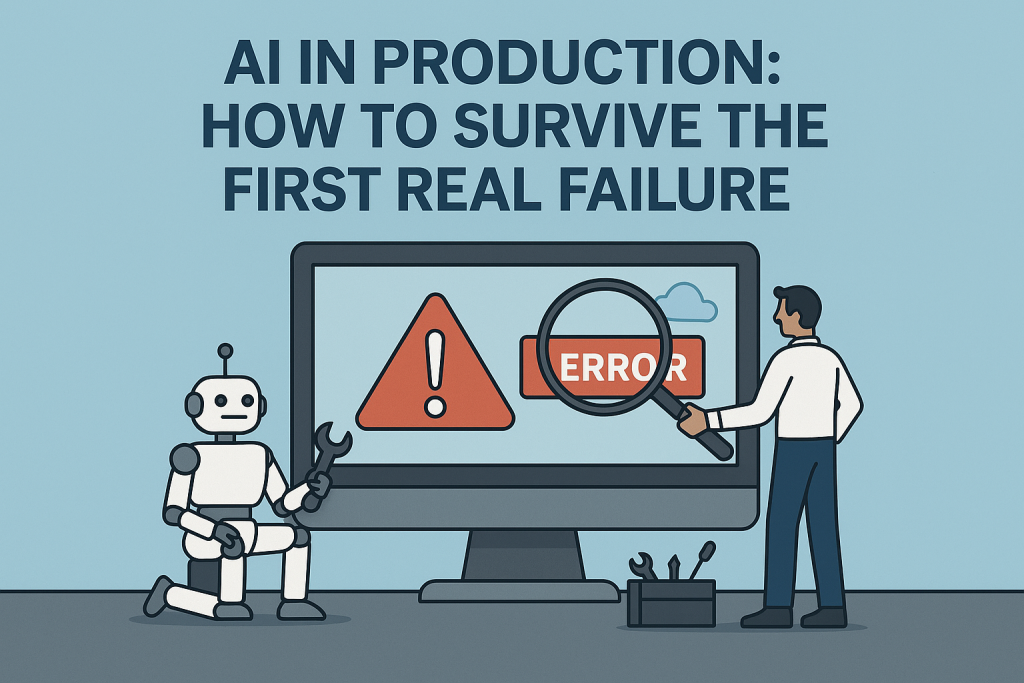(And what to do next Monday)

You rolled out your first AI helper. It passed demos, saved time in pilot, and nobody panicked. Then production happened.
A model drifted. An integration changed shape. A “green by optimism” signoff turned out not to be green. Support tickets spiked. Now you need a calm, repeatable way to put the fire out—and a plan so the next one is smaller and rarer.
This post is the playbook I wish someone had handed me the first time an AI feature failed under real traffic.
Why AI fails in production (and why that’s normal)
AI doesn’t fail because it’s “AI.” It fails for the same reasons distributed systems do—plus a few new ones:
- Data goes weird. Inputs shift (seasonality, new products, new slang), labels skew, or upstream formatting changes. That’s model drift, and it’s expected once real users arrive. [AID All-In Design-V4 | Word]
- Integration seams move. A harmless API tweak, a logging change, or a new sanitizer silently breaks your prompt or schema. (Automation magnifies “small” differences). [SniceThen | Word]
- Green by optimism. You declared success on staging screenshots. Regulators and customers ask for evidence, not vibes—especially under risk‑tiered regimes. [yahoo.com], [AID All-In Design-V4 | Word]
- Compliance surprise. Someone notices you can’t explain a decision, or incident reporting wasn’t wired. (This is where “make green provable” matters.) [yahoo.com], [oecd.org]
Failures are normal. What matters is fast rollback, honest diagnosis, and adding a small guardrail so the same thing doesn’t bite you twice.
Monday‑morning checklist (use this when it breaks)
1) Identify the failure (30–60 minutes).
Write exactly one paragraph: What broke, who noticed, scope of impact, first timestamp. Keep it readable by non‑engineers. This becomes the top of your incident note. (Regulators and execs want this first.) [yahoo.com]
2) Roll back (instantly).
Flip the feature flag / kill switch and return to the last known good behavior. If you don’t have one, build it this week (below). The goal is to stop user harm before you get clever. [SniceThen | Word]
3) Communicate (15 minutes).
Two sentences to stakeholders:
- “We disabled <feature> at <time> after <symptom> increased. No data loss/PII exposure confirmed. Next update <time>.”
If customer‑facing, mirror the same clarity. Short, precise, accountable. [yahoo.com]
4) Triage the root (same day).
Decide which bin it’s in: Data, Code/Prompt, Config, Process.
- Data: new input distribution, missing fields, label drift.
- Code/Prompt: schema mismatch, brittle instructions, temperature or tool call changes.
- Config: wrong model version, token limits, timeout/retry logic.
- Process: missing test, skipped review, “green” with no evidence. [AID All-In Design-V4 | Word]
5) Patch, then test like it’s production (same day).
Reproduce with a production‑like sample (real traffic patterns, redacted if needed). Validate acceptance signals, not screenshots. Add one guardrail (monitor, alert, or test) before you re‑enable. [SniceThen | Word]
6) Re‑enable with a ramp (24–48 hours).
10% → 50% → 100%, watching the guardrail metrics between steps. If anything twitches, back off in seconds (the flag). [SniceThen | Word]
7) Close the loop (48–72 hours).
Post a one‑page incident note: what broke, why, how you fixed it, what proof makes it green now, and the new guardrail you added. This satisfies both internal trust and external audit duties. [yahoo.com], [AID All-In Design-V4 | Word]
Guardrails you can add this week (cheap, high‑leverage)
A) Kill switch + last‑known‑good
- Feature flag around the AI path.
- Deterministic fallback: cached output, previous model version, or legacy logic.
- Practice flipping it. (A switch you’ve never tested is theater.) [SniceThen | Word]
B) Drift watch (the 80/20 version)
- Track a few input distribution stats (length, key fields present, language mix) and a stability metric (e.g., cosine similarity of embeddings across a rolling window).
- Alert on “big enough” changes; don’t boil the ocean day one. [AID All-In Design-V4 | Word]
C) Output shape tests
- Schematize the output (JSON keys, ranges, enumerations).
- Treat schema violation as a failure: retry once, then fallback.
- Log every violation for 7–14 days for inspection. [SniceThen | Word]
D) Canary prompts / golden sets
- Keep 10–20 “golden” inputs that must pass before deploy.
- Include edge cases and sensitive scenarios (privacy, fairness).
- Fail the deploy if any golden test regresses. [AID All-In Design-V4 | Word]
E) Evidence binder (lightweight)
- One folder per AI feature: model/version, acceptance signal, last drift chart, last incident note, and gate signoffs.
- This is how “green” becomes provable under risk‑tiered regimes. [yahoo.com], [oecd.org]
Make “green” mean something (so compliance isn’t a surprise)
Different jurisdictions and standards say it differently, but they rhyme:
- EU AI Act: risk‑tiered duties, prohibited practices, incident reporting, documentation; GPAI expectations are phasing in. If your feature is high‑risk, “we tested it” isn’t enough—you need traceable documentation and post‑market monitoring. [yahoo.com]
- NIST AI RMF: Map → Measure → Manage → Govern. It’s a voluntary framework, but it’s the easiest way to show you took risk seriously: context, evals, controls, and continuous improvement. [AID All-In Design-V4 | Word]
- OECD Principles (updated 2024): transparency, robustness, safety, accountability. Your one‑page incident note + evidence binder hits these. [oecd.org]
If you can’t show what counts as green—owner, evidence, date—you’ll struggle in audits and boardrooms alike. Build the habit now; it pays for itself the first time something goes bump. [yahoo.com], [oecd.org]
Patterns that prevent the next 3AM page
1) Treat AI releases like flight ops, not slideware.
- Pre‑flight (golden tests), a flight plan (ramp schedule), in‑flight monitoring (drift + errors), and a landing checklist (acceptance signal met).
- When in doubt, go around: rollback and re‑approach. [SniceThen | Word]
2) Make explainability human, not just math.
- One paragraph: “For input like X, the system returns Y because Z; here are the guardrails.”
- Link to the technical details if needed, but keep the human explanation handy for customers and regulators. Financial supervisors have been pushing this direction for years. [bis.org], [bis.org]
3) Practice incident drills.
- Once a month: pick a feature, flip the flag off in staging, send the comms draft, and restore. The first real outage shouldn’t be your first “hello” to the process. [SniceThen | Word]
4) Don’t ignore the seams.
- Put contract tests between the AI service and its immediate neighbors (inputs, tools, storage). Most “AI bugs” are seam bugs. [SniceThen | Word]
5) Build small, scoped automation first.
- Narrow tasks fail smaller and are easier to roll back. As you widen scope, keep the rollback muscle strong. (Risk frameworks reward this.) [AID All-In Design-V4 | Word]
Quick templates you can paste into your repo/wiki
1) Incident note (one page)
Feature: [name]
Start time / Detection: [UTC stamp] / [who/what noticed]
Impact: [users affected, severity, customer impact]
Actions taken: [flag off time], [fallback path]
Root cause bin: [Data | Code/Prompt | Config | Process] → [one line]
Fix: [patch or rollback], [validation result], [ramp schedule]
Evidence for green: [metric X over Y period, golden set pass, logs link]
Guardrail added: [monitor/test/alert]
Owner: [name], Reviewers: [names], Next review: [date]
This single page answers 90% of stakeholder and audit questions under EU AI Act‑style expectations and the NIST RMF “Govern/Manage” functions. [yahoo.com], [AID All-In Design-V4 | Word]
2) Acceptance signal (put beside your feature flag)
For [input scope], the system is “green” when:
- [Metric 1] ≥ [threshold] (e.g., accuracy / pass% on golden set)
- [Metric 2] ≤ [threshold] (e.g., schema error rate, latency)
- No new incidents in [window], drift metric within [band]
Owner signs: [name] / [date]
This turns “looks good” into “counts as good.” [yahoo.com]
What we’ll do next week (small steps, real wins)
Pick one feature already in production and do three things:
- Wire or test the kill switch. Flip it in staging and verify the fallback actually works.
- Add one guardrail. Schema validation or a tiny drift watch—your choice.
- Write the acceptance signal. One paragraph, two numbers.
Timebox to half a day. You’ll sleep better, your team will ship braver, and the first 3AM failure will be a page, not a headline.
Sources & further reading
- NIST AI Risk Management Framework (Map/Measure/Manage/Govern; practical controls & continuous improvement). [AID All-In Design-V4 | Word]
- EU AI Act—application & obligations (risk tiers, documentation, incident reporting; phased rollout & enforcement coordination via the AI Office). [yahoo.com]
- OECD AI Principles (updated 2024) (transparency, robustness, accountability as shared global language). [oecd.org]
- Process & scale realities (why failures rise with team size; the value of explicit practices you’ll actually use). [SniceThen | Word]

Leave a Reply